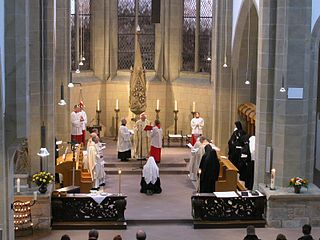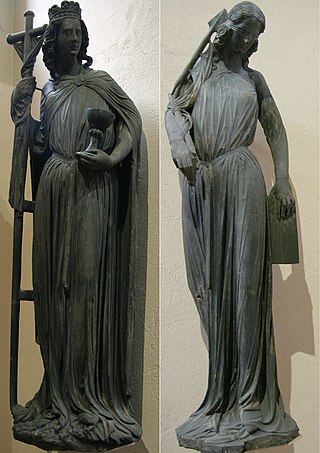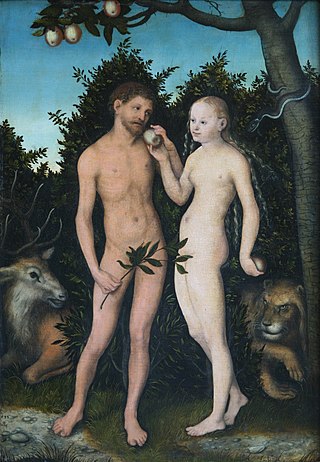
Hildegard of Bingen OSB,, also known as the Sibyl of the Rhine, was a German Benedictine abbess and polymath active as a writer, composer, philosopher, mystic, visionary, and as a medical writer and practitioner during the High Middle Ages. She is one of the best-known composers of sacred monophony, as well as the most recorded in modern history. She has been considered by a number of scholars to be the founder of scientific natural history in Germany.

Books of hours are Christian prayer books, which were used to pray the canonical hours. The use of a book of hours was especially popular in the Middle Ages, and as a result, they are the most common type of surviving medieval illuminated manuscript. Like every manuscript, each manuscript book of hours is unique in one way or another, but most contain a similar collection of texts, prayers and psalms, often with appropriate decorations, for Christian devotion. Illumination or decoration is minimal in many examples, often restricted to decorated capital letters at the start of psalms and other prayers, but books made for wealthy patrons may be extremely lavish, with full-page miniatures. These illustrations would combine picturesque scenes of country life with sacred images.
The Letters of Abelard and Heloise are a series of passionate and intellectual correspondences written in Latin during the 12th century. The authors, Peter Abelard, a prominent theologian, and his pupil, Heloise, a gifted young woman later renowned as an abbess, exchanged these letters following their ill-fated love affair and subsequent monastic lives.

Religious vows are the public vows made by the members of religious communities pertaining to their conduct, practices, and views.

Lorsch Abbey, otherwise the Imperial Abbey of Lorsch, is a former Imperial abbey in Lorsch, Germany, about 10 km (6.2 mi) east of Worms. It was one of the most important monasteries of the Carolingian Empire. Even in its ruined state, its remains are among the most important pre-Romanesque–Carolingian style buildings in Germany.

In the Catholic Church, a consecrated virgin is a woman who has been consecrated by the church to a life of perpetual virginity as a bride of Christ. Consecrated virgins are consecrated by the diocesan bishop according to the approved liturgical rite.
Apology of al-Kindi is a medieval theological polemic making a case for Christianity and drawing attention to alleged flaws in Islam. The word "apology" is a translation of the Arabic word رسالة, and it is used in the sense of apologetics.
Life of Soul is a short anonymous prose tract written in the late Middle English of the English Midlands about 1400 or a little earlier.

Scivias is an illustrated work by Hildegard von Bingen, completed in 1151 or 1152, describing 26 religious visions she experienced. It is the first of three works that she wrote describing her visions, the others being Liber vitae meritorum and De operatione Dei. The title comes from the Latin phrase Sci vias Domini. The book is illustrated by 35 miniature illustrations, more than that are included in her two later books of visions.

The title Virgin is an honorific bestowed on female saints and blesseds, primarily used in the Eastern Orthodox Church and the Catholic Church.

The Hunterian Psalter is an illuminated manuscript of the 12th century. It was produced in England some time around 1170, and is considered a striking example of Romanesque book art. The work is part of the collection of the Glasgow University Library, cataloged as Sp Coll MS Hunter U.3.2 (229), which acquired the book in 1807. It derives its colloquial name, the "Hunterian Psalter", from having been part of the collection of 18th century Scottish anatomist and book collector William Hunter, who willed his collection to the University. It has also at times been known as the "York Psalter", owing to its supposed northern English origin in the city of York.

Dominic of Evesham was a medieval prior of Evesham Abbey in England and writer of religious texts. Probably a native Englishman, there is some confusion about when he became a monk, but by 1104 he was at Evesham and by 1125 he held the office of prior. He is chiefly known for his religious works, including one on the miracles of the Virgin Mary that was an important source for later writings on the subject. Four of his works are still extant.

Ecclesia and Synagoga, or Ecclesia et Synagoga in Latin, meaning "Church and Synagogue", are a pair of figures personifying the Church and the Jewish synagogue, that is to say Judaism, found in medieval Christian art. They often appear sculpted as large figures on either side of a church portal, as in the most famous examples, those at Strasbourg Cathedral. They may also be found standing on either side of the cross in scenes of the Crucifixion, especially in Romanesque art, and less frequently in a variety of other contexts.

Women play significant roles in the life of the Catholic Church, although excluded from the Catholic hierarchy of bishops, priests, and deacons. In the history of the Catholic Church, the church often influenced social attitudes toward women. Influential Catholic women have included theologians, abbesses, monarchs, missionaries, mystics, martyrs, scientists, nurses, hospital administrators, educationalists, religious sisters, Doctors of the Church, and canonised saints. Women constitute the majority of members of consecrated life in the Catholic Church: in 2010, there were around 721,935 professed women religious. Motherhood and family are given an exalted status in Catholicism, with The Blessed Virgin Mary holding a special place of veneration.

The Howard Psalter and Hours is a 14th-century illuminated prayerbook. It includes a liturgical Psalter with canticles and litany, the Office of the Dead, a calendar of East Anglian origin and an incomplete Hours of the Passion. It was produced between 1310 and 1320. It is written in Latin in a Gothic script in two columns per page. There are 115 extant folios which measure 360 by 235 mm. The text block occupies an area of 250 by 166 mm. It is bound together with the De Lisle Psalter, a contemporary psalter.
Robert of Cricklade was a medieval English writer and prior of St Frideswide's Priory in Oxford. He was a native of Cricklade and taught before becoming a cleric. He wrote several theological works as well as a lost biography of Thomas Becket, the murdered Archbishop of Canterbury.
Robert of Bridlington was an English clergyman and theologian who was the fourth prior of Bridlington Priory. He held the office during the period from 1147 to 1156, but it is not clear if he died in office or resigned before his death. Besides holding monastic office, he wrote a number of commentaries on biblical books as well as other treatises. Not all of his works have survived to the current day.

Dives and Pauper is a 15th-century commentary and exposition on the Ten Commandments written in dialogue form. Written in Middle English, while the identity of the author is unknown, the text is speculated to have been authored by a Franciscan friar. Dives and Pauper is structured as a dialogue between two interlocutors, a wealthy layman (Dives) and a spiritual poor man with many similarities to a friar (Pauper). The text engages with orthodox Catholic theology, and further discusses many questions relevant to Wycliffism, an English movement which criticised doctrines and abuses of the Church, which was condemned as heretical by church authorities.
The Life of Saint Apolinaria is a legendary Greek saint's life. It is about Apolinaria, a transvestite virgin girl living as a monk in the desert of Scetis in Egypt. It is the Greek counterpart to the Coptic Legend of Hilaria.
Kim E. Power is an Australian academic, feminist theologian and church historian, who was a co-founder of the Golding Centre for Women's History, Theology and Spirituality at the Australian Catholic University.













